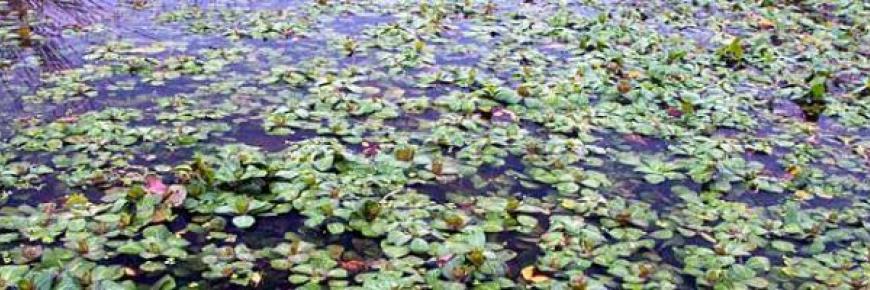Japanese knotweed

Japanese knotweed ©GBNNSS
Japanese knotweed (Fallopia japonica) is one of the most notorious invasive alien species in the UK today. Native to Japan, Taiwan and Northern China, it was introduced to Britain in the 19th century as an ornamental plant. With its bamboo like stems, it can grow extremely rapidly up to 10cm per day, forming dense thickets. Roots can be found down to 3m and belowground roots can spread from the emergent stems by up to 7m.
Japanese knotweed spreads solely by vegetative means (it does not produce viable seeds in the UK) and a new plant can grow from a tiny fragment of root or stem. The plant has negative impacts on biodiversity through smothering and outcompeting native vegetation, when found along riverbanks and watercourses this can often contribute to erosion which leads to flooding. The root rhizomes can also cause serious damage to structures as they have been found growing through pavements and building foundations. While it has a reputation to be able to pierce concrete there is limited evidence to suggest that this is true, instead it most likely exploits cracks and structural weaknesses to break through, making cracks worse in the process.

Japanese knotweed flowers ©GBNNSS
Damage caused by this species and the high costs of eradication costs the UK economy approximately £200 million per year. As disposal of material is classified as controlled waste, disposal can be very costly. The presence of Japanese knotweed on land or property can reduce its value as well as that of adjacent areas.
Native to: Japan, Taiwan, northern China
Habitat: Urban areas particularly waste land, railways and road sides. Also found along river banks
I’ve found Japanese knotweed on my land. What should I do?
If Japanese knotweed is found on your land it should be handled with care and best done by professionals. It is not an offence to simply have this plant on your land, but it is an offence under Section 9 of the Wildlife and Countryside Act to plant or otherwise cause this species to grow in the wild. This means that if you do have Japanese knotweed growing you need to take action to control it to prevent it spreading, you can be held liable for costs incurred from the spread of Japanese knotweed into adjacent properties.
While the threat is serious, it CAN be eradicated, especially when caught early. Glyphosate based herbicide is one of the best methods for tackling this species. This can be applied by stem injection or foliar spray which can depend on the size of infestation, money available and presence of other species. Stem injection (where herbicide is injected directly into the stem) is more labour intensive but is a targeted approach whereas foliar spray is more practical for larger infestations. This should be continued annually for a minimum of three years to ensure complete eradication.
 Japanese knotweed can re-grow from tiny root fragments, therefore it is extremely important that the soil surrounding the plant is not disturbed. Cutting it is not advised because this method is likely to lead to fragments breaking off which can then regrow. Cutting the plant can also cause it to regrow more vigorously.
Japanese knotweed can re-grow from tiny root fragments, therefore it is extremely important that the soil surrounding the plant is not disturbed. Cutting it is not advised because this method is likely to lead to fragments breaking off which can then regrow. Cutting the plant can also cause it to regrow more vigorously.
Cuttings of Japanese knotweed are considered to be hazardous waste and must be treated accordingly (e.g. burnt on site). If disposing material offsite, you must use a registered waste carrier and an authorised landfill to do so. You may need special permission from the Environment Agency or Natural England if the infestation is near water or on protected land. Check out the link below for government guidance on the above. For more information and detail on these eradication methods download the GBNNSS Japanese knotweed management guidance document.

Japanese knotweed new growth ©GBNNSS
I want to report an infestation of Japanese knotweed
If you are unsure whether you have Japanese knotweed on your land images can be emailed to NNNSI and we can help with identification. We can also help out with management advice. If you report a sighting to us, we can update our records on the distribution of this species which will can be used to formulate future countywide management practices.
To record a sighting, take a photo, note the date and location and any other additional information such as abundance or size of area.
- Report online: NNNSI@norfolk.gov.uk
- Take a look at our project on the River Wensum and what you can do if you find Japanese knotweed in the area

